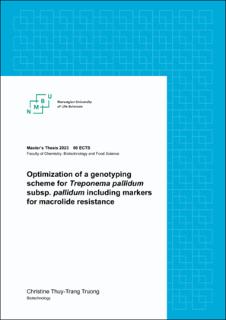| dc.contributor.advisor | Daniel Straume | |
| dc.contributor.advisor | André Ingebretsen | |
| dc.contributor.advisor | Veselka Petrova Dimova-Svetoslavova | |
| dc.contributor.advisor | Fredrik Müller | |
| dc.contributor.author | Truong, Christine Thuy-Trang | |
| dc.date.accessioned | 2023-07-14T16:27:09Z | |
| dc.date.available | 2023-07-14T16:27:09Z | |
| dc.date.issued | 2023 | |
| dc.identifier | no.nmbu:wiseflow:6839614:54592641 | |
| dc.identifier.uri | https://hdl.handle.net/11250/3078959 | |
| dc.description.abstract | Syfilis er en seksuelt overførbar infeksjon, og er et viktig folkehelseproblem både i Norge og i verden. Forekomst av syfilis har økt i de senere årene, spesielt blant menn som har sex med menn (MSM). Bakterien Treponema pallidum subspecies pallidum (TPA), en spiroket som ikke lar seg dyrke, er årsaken til syfilis. Diagnostisering av syfilis gjøres ved hjelp av antistofftest mot TPA antigen, eller ved direkte identifisering av TPA DNA med polymerasekjedereaksjon (PCR). Ubehandlet syfilisinfeksjon, kan deles inn i ulike stadier som gir forskjellige symptomer: primær, sekundær, latent og tertiær. Det er ikke utviklet noen vaksine mot TPA. Penicillin er førstevalg ved behandling av syfilis. Azitromycin, et makrolidantibiotikum, har også vært anvendt i behandling av syfilis og brukes også i behandling av andre kjønnssykdommer. Resistens mot makrolidantibiotika i TPA har imidlertid blitt detektert globalt.
TPA kan deles inn i to hovedgrupper utfra molekylær subtyping: Nichols- og SS14- stammer. Kombinasjonen av molekylær genotyping av TPA og resistens mot makrolidantibiotika er viktig for å forstå epidemiologien ved syfilis i Norge, og overvåkning av antibiotikaresistens. Genotypiskbestemmelse av TPA, inkludert markører for makrolidresistens, må først optimaliseres og etableres.
Molekylær subtyping av TPA utføres ved multilokus sekvens typing (MLST) av tre loci: TP0136, TP0548 og TP0705. MLST består av en nested PCR etterfulgt av Sanger sekvensering for hvert locus. Allele profiler og sekvenstyper blir bestemt av PubMLST. For deteksjon av makrolidresistente TPA, som skyldes punktmutasjonene A2058G eller A2059G i ett eller begge kopier av 23S rRNA-genet, ble det utviklet en SimpleProbe real-time PCR analyse etterfulgt av en smeltepunktsanalyse. Makrolidresistente TPA har en lavere smeltepunkts-temperatur enn villtype TPA.
Det ble samlet inn 81 pasientprøver fra oktober 2020 til september 2022. Ved molekylær subtyping ble det avdekket ni forskjellige sekvenstyper, deriblant tre nye sekvenstyper. Makrolidresistens kan også bekreftes blant disse prøvene. | |
| dc.description.abstract | Syphilis, a sexually transmitted disease, is an important public health problem, both in Norway and worldwide. The incidence of syphilis has increased in the recent years, particularly among men who have sex with men (MSM). Infection with the uncultivated spirochaete bacteria Treponema pallidum subsp. pallidum (TPA), is the cause of syphilis. Syphilis can be diagnosed with antibody test against TPA antigen or by directly identification of TPA DNA with polymerase chain reaction (PCR). Untreated syphilis infection can be divided into different stages that give different symptoms: primary, secondary, latent, and tertiary. No vaccine against TPA has been developed yet. Penicillin is the first choice of antibiotic treatment for syphilis. Azithromycin, a macrolide antibiotic, has shown to be an effective treatment of early syphilis in many cases as well as treating infections with other venereal diseases. However, macrolide antibiotic resistance in TPA has been detected globally.
By molecular characterization, TPA can be divided into two main lineages: Nichols- and SS14-like strains. The combination of molecular genotyping of TPA and macrolide antibiotic resistance is important for understanding the epidemiology of syphilis in Norway, and the surveillance of antibiotic resistance. Thus, a genotyping scheme for TPA including markers for macrolide resistance, need to be established and optimized.
Molecular characterization of TPA was performed by multi-locus sequence typing (MLST) of three loci: TP0136, TP0548, and TP0705. MLST consists of a nested PCR followed by Sanger sequencing of each of the three loci. The allelic profiles and sequence type can be determined by PubMLST. For detection of macrolide resistance in TPA, due to point mutations in position A2058G or A2059G in one or both copies of the 23S rRNA gene, a SimpleProbe real-time PCR assay was developed followed by a melting point analysis. Macrolide resistance in TPA is detected by having a lower melting temperature than the wild-type.
Eighty-one clinical samples were collected from October 2020 to September 2022. Molecular characterization of TPA revealed nine different sequence types, including three novel sequence types. Macrolide resistance was also confirmed among the collected samples. | |
| dc.language | eng | |
| dc.publisher | Norwegian University of Life Sciences | |
| dc.title | Optimization of a genotyping scheme for Treponema pallidum subsp. pallidum including markers for macrolide resistance | |
| dc.type | Master thesis | |
